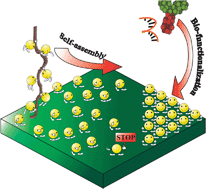Fundamentals and application of ordered molecular assemblies to affinity biosensing
Abstract
Organization of biomolecules in two/three dimensional

Maintenance work is planned for Wednesday 1st May 2024 from 9:00am to 11:00am (BST).
During this time, the performance of our website may be affected - searches may run slowly and some pages may be temporarily unavailable. If this happens, please try refreshing your web browser or try waiting two to three minutes before trying again.
We apologise for any inconvenience this might cause and thank you for your patience.
* Corresponding authors
a
Department of Science and Technology Centre on Biomolecular Electronics, Biomedical Instrumentation Section, Materials Physics & Engineering Division, National Physical Laboratory (Council of Scientific & Industrial Research) Dr K. S. Krishnan Marg, New Delhi-110012, India
E-mail:
bansi.malhotra@gmail.com
Tel: +91-11-45609152
b Department of Applied Chemistry, Institute of Technology, Banaras Hindu University, Varanasi-221005, India
c Department of Physics & Astrophysics, University of Delhi, Delhi-110007, India
d Centre for Nano Bioengineering & Spin Tronics, Chungnam National University, 220 Gung-Dong, Yuseong-GU, Daejeon, Korea
e Department of Biotechnology, Delhi Technological University, Shabad Daulatpur, Main Bawana Road, Delhi 110042, India
Organization of biomolecules in two/three dimensional

 Please wait while we load your content...
Something went wrong. Try again?
Please wait while we load your content...
Something went wrong. Try again?
Z. Matharu, A. J. Bandodkar, V. Gupta and B. D. Malhotra, Chem. Soc. Rev., 2012, 41, 1363 DOI: 10.1039/C1CS15145B
To request permission to reproduce material from this article, please go to the Copyright Clearance Center request page.
If you are an author contributing to an RSC publication, you do not need to request permission provided correct acknowledgement is given.
If you are the author of this article, you do not need to request permission to reproduce figures and diagrams provided correct acknowledgement is given. If you want to reproduce the whole article in a third-party publication (excluding your thesis/dissertation for which permission is not required) please go to the Copyright Clearance Center request page.
Read more about how to correctly acknowledge RSC content.
 Fetching data from CrossRef.
Fetching data from CrossRef.
This may take some time to load.
Loading related content
